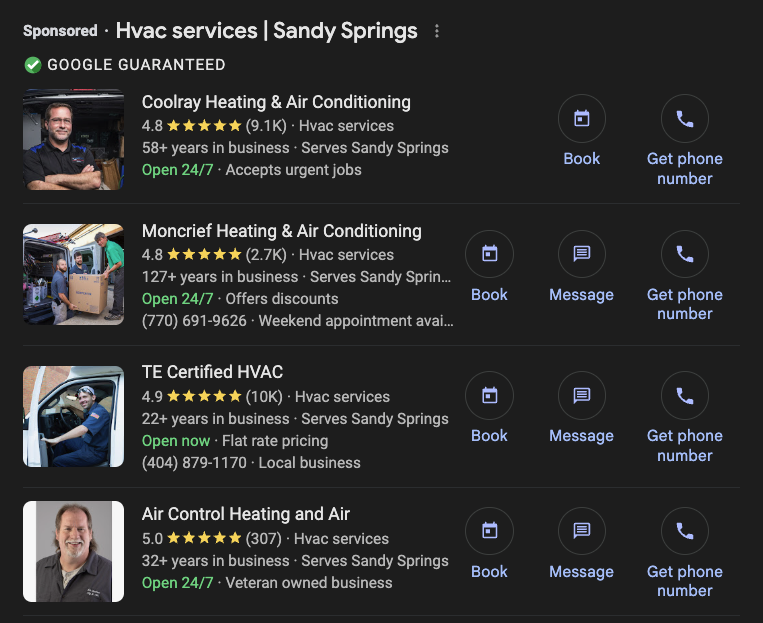
Local Service Ads vs Google Ads: What To Know
Book An Intro Call
What Are Google LSA Ads?
Google Local Services Ads (LSA) are pay-per-lead advertisements designed specifically for local service providers. They appear prominently at the top of Google search results, above traditional paid search ads and organic results, particularly for local service-related searches.

Key Features of Google LSA Ads:
-
Top-of-Page Placement
-
They appear at the very top of Google search results, highly visible to users.
-
-
Pay-Per-Lead Model
-
Advertisers pay only when a genuine lead contacts them directly through the ad.
-
-
Google Guarantee or Google Screened Badge
-
Businesses undergo background checks and verification.
-
The "Google Guarantee" badge offers customers reimbursement if they're unhappy with the services received (for certain service types).
-
"Google Screened" is specifically for professionals like lawyers, realtors, or financial advisors.
-
-
Lead Quality Assurance
-
Google provides an easy way for advertisers to dispute invalid or spam leads, potentially receiving refunds for non-legitimate inquiries.
-
-
Trust and Credibility
-
The verification process boosts trust, improving lead conversion rates.
-
-
Easy Management
-
Ads require minimal ongoing management compared to traditional PPC campaigns, as Google handles most aspects of targeting and bidding.
-
Industries Commonly Using LSAs:
-
Plumbing
-
HVAC
-
Electricians
-
Roofing
-
Legal Services
-
Cleaning Services
-
Pest Control
-
Real Estate
Benefits of Google LSA Ads:
-
Visibility: Guaranteed top placement boosts your local visibility significantly.
-
Cost-Effectiveness: Paying only for leads, not clicks.
-
Trustworthiness: Google's vetting increases consumer trust.
-
Simplified Marketing: Easier to manage than traditional PPC.
Cons of Google LSA Ads
Google Local Services Ads (LSAs) offer several advantages, but there are notable disadvantages or cons worth considering:
Cons of Google Local Services Ads (LSA)
-
Limited Control Over Ad Targeting
-
Unlike traditional PPC, you can't select keywords directly.
-
Google decides when and how your ad is shown, potentially limiting control over precise targeting.
-
-
Competition and Costs
-
Popular service categories can be highly competitive, driving up lead prices.
-
Costs per lead can fluctuate unpredictably, making budgeting challenging.
-
-
Limited Availability and Eligibility
-
LSAs are available only for specific service industries and regions.
-
Strict vetting requirements can exclude newer or smaller businesses.
-
-
Opaque Ranking Factors
-
Google's method for ranking LSAs isn't transparent, making optimization difficult.
-
Customer reviews, responsiveness, and proximity heavily influence ranking, leaving businesses less direct control.
-
-
Lead Quality Variability
-
Although Google tries to filter invalid leads, some low-quality inquiries still slip through.
-
Disputing and receiving refunds for poor-quality leads can be tedious and not always successful.
-
-
Dependency on Customer Reviews
-
Success heavily depends on maintaining consistently high ratings.
-
Negative reviews can significantly hurt your visibility and performance.
-
-
Limited Brand Exposure
-
LSAs provide limited opportunities for branding or detailed messaging, primarily emphasizing reviews and ratings.
-
-
Less Insight into Performance Metrics
-
Limited detailed analytics compared to standard Google Ads.
-
Minimal insights into user behavior, keyword data, and detailed click metrics.
-
-
Inconsistent Lead Volume
-
Businesses may experience fluctuating lead volumes due to competition, seasonal factors, or changes in Google's algorithm.
Bottom Line: While Google LSAs are highly beneficial for visibility and generating local leads, businesses must consider the drawbacks carefully. Those accustomed to detailed PPC management or seeking precise control over targeting, budget predictability, and branding may find LSAs somewhat restrictive or less transparent than traditional paid search campaigns.
What Are Google Search Ads?
Google Search Ads (also known as PPC or pay-per-click ads) are text-based advertisements displayed directly on Google's search engine results pages (SERPs) in response to specific keywords typed by users. At RedBrick, we offer Pay-Per-Click Management services for home service businesses that are looking to take the next step.

How Do Google Search Ads Work?
When a user searches Google using certain keywords or phrases, your ad may appear prominently above or below organic search results, clearly labeled as "Ad."
-
Payment model: Advertisers pay each time a user clicks the ad (Cost Per Click or CPC), regardless of whether it results in a lead or sale.
-
Ad Placement: Ads appear above or below organic search results based on bid, relevance, and ad quality.
Key Features of Google Search Ads:
-
Keyword-Based Targeting:
-
Ads triggered by chosen keywords or phrases you explicitly target.
-
-
Auction-Based Pricing:
-
You bid against competitors for placement; bids combined with ad quality (Quality Score) determine positioning and CPC.
-
-
Complete Control:
-
Control over keywords, bidding strategies, ad messaging, extensions, targeting (location, demographics, device type), scheduling, and budget.
-
-
Immediate Results:
-
Instant visibility, ideal for driving traffic and leads quickly.
-
-
Highly Measurable:
-
Extensive analytics and performance tracking using Google Ads interface and Google Analytics.
-
Typical Components of a Google Search Ad:
-
Headline(s): Prominent clickable text (up to 3 headlines).
-
Description(s): Expanded messaging about your products/services (2 descriptions).
-
Display URL: Visible website URL, customizable for clarity.
-
Ad Extensions: Additional information such as phone numbers, site links, pricing, location, or special offers.
Advantages of Google Search Ads:
-
Precision and control: Highly targeted ads based on keywords, demographics, location, and user intent.
-
Rapid visibility: Quickly gain exposure, generate leads, and drive sales.
-
Rich analytics: Comprehensive performance data helps optimize campaigns continually.
Cons or Limitations of Google Search Ads:
-
Can Be Expensive: Highly competitive keywords can quickly inflate CPC.
-
Requires Active Management: Regular monitoring, optimization, and tweaking required.
-
Potential for Click Waste: You pay for all clicks, not just leads.
-
Learning Curve: Optimization requires significant knowledge and experience for best results.
Ideal Use Cases for Google Search Ads:
-
Immediate product/service launches
-
Competitive markets needing visibility quickly
-
Targeted campaigns for high-value, intent-driven leads
LSA vs. Google Search Ads: Brief Comparison
| Feature | Google LSA Ads | Google Search Ads |
|---|---|---|
| Payment Model | Pay per lead | Pay per click |
| Control Over Keywords | Limited | Complete |
| Management Complexity | Simple | Advanced |
| Industries Supported | Limited industries/local | Broad industries/global |
| Lead Quality Assurance | Moderate-to-High | Variable; dependent on targeting |
| Visibility | Very High (Top Placement) | High (but competitive bidding) |
Bottom Line
Google Search Ads provide highly controlled, scalable, and immediate visibility, ideal for businesses aiming to attract precise traffic using detailed targeting and keyword control.